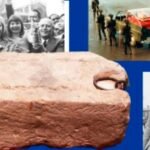Lost fragments of the Stone of Destiny have surfaced after decades in hiding. A new study traces their paths and uncovers secrets about Scotland’s past.
The Stone of Destiny, a key symbol in Scottish history, saw its missing pieces come to light this month. Researchers led by Professor Sally Foster at the University of Stirling revealed details in a fresh report that ties back to a daring 1950 theft from London’s Westminster Abbey.
The Bold 1950 Theft and Its Lasting Echo
Four young Scottish nationalists grabbed the Stone of Destiny on Christmas Day in 1950. They aimed to bring it back home from Westminster Abbey, where it sat under the coronation chair for over 600 years. This act sparked outrage and closed the England-Scotland border for the first time in four centuries.
The stone broke into two main parts during the escape. The group, including Ian Hamilton and Kay Matheson, hid it in Scotland for months. They left it at Arbroath Abbey in April 1951 for police to find. This event boosted Scottish pride and fueled talks of independence.
The theft highlighted deep tensions between Scotland and England. King Edward I had taken the stone in 1296 as a sign of conquest. For Scots, it stood for their ancient kings and right to rule. The 1950 raid turned it into a modern icon of resistance.

How the Stone Broke and Got Fixed
Stonemason Robert Gray, a secret supporter of the nationalists, fixed the stone in 1951. He glued the big pieces back together but ended up with extra bits from the damage. Gray numbered these small fragments, likely 34 in total, and shared them with friends and allies.
Gray kept quiet about the exact count until his death in 1975. He gave pieces to people tied to the Scottish National Party, or SNP. Some went to family members or far-off contacts. This spread turned the fragments into private treasures rather than public displays.
The main stone weighs 335 pounds and shows a mark reading XXXV in Roman numbers on its base. Experts think this nods to the 34 fragments plus the repaired block itself. Gray’s work added a layer of mystery to the stone’s story.
Hunt for the Scattered Fragments Begins
Professor Foster started her deep dive years ago under a project called Authenticity’s Child. She dug through old letters, photos, and museum files to track the pieces. At first, only one fragment was known to the public. Now, she has pinned down 17 more.
Foster’s team used laser scans and family stories to verify each piece. Many owners stayed silent because the fragments felt like stolen goods. But recent buzz from the study has brought forward new leads. People shared family heirlooms with proof of origin.
This research shows how the bits traveled far. One ended up in Australia, another in Canada. Politicians and everyday folks held onto them as symbols of Scottish spirit. The study paints a picture of a stone that lives on in pieces around the world.
- Key discoveries from Foster’s work include fragments in jewelry like lockets and brooches.
- Some pieces went to SNP leaders, strengthening ties to the independence movement.
- Public tips since the study’s release have added more clues to the puzzle.
Where the Fragments Ended Up Around the World
The paths of these pieces tell a tale of global connections. Foster mapped out locations from Europe to distant lands. Here is a table of some verified fragments and their stories:
| Fragment Number | Location/Owner | Details |
|---|---|---|
| Unknown | Queensland Museum, Australia | Gifted to a supporter; now on display as a historical item. |
| 1 | SNP Headquarters, Scotland | Given to Alex Salmond; kept as a party symbol. |
| Several | Jewelry collections | Turned into necklaces for figures like Winnie Ewing and Margo MacDonald. |
| Unknown | Diamond Jubilee Stagecoach, UK | Embedded in the royal carriage used in 2023 events. |
| Unknown | Calgary Herald, Canada | Mounted behind a journalist’s desk as a memento. |
This table highlights just a few of the 17 traced pieces. Many more may exist in private hands. The spread shows how the 1950 events rippled out, linking Scots abroad to their roots.
Foster notes that families treated these bits with care, passing them down as heirlooms. One piece went into a locket for a thief’s loved one. Another became a brooch. These personal touches add emotional weight to the stone’s legacy.
What These Finds Mean for Scotland Today
The fragments reveal more than just rock chips. They spotlight themes of identity and power in Scottish history. As the stone returned to Scotland in 1996 and starred in King Charles III’s 2023 coronation, these pieces remind us of ongoing debates over sovereignty.
Experts link this to broader trends in heritage studies. Small objects like these carry big meanings, often more than the whole. Foster calls for more work to map all fragments and replicas. This could help museums share the full story without moving the main stone.
Recent events, like the stone’s trip to London for the coronation, stirred fresh interest. Ties to the SNP and independence push keep the topic alive. The study builds trust through solid facts and calls for public input to fill gaps.
The discoveries tie into current trends in archaeology, where personal stories shape big narratives. For Scots, these bits solve old mysteries and spark pride. They show how history fragments but endures.
Share your thoughts on this story in the comments below. Have you heard family tales about the Stone of Destiny? Pass it on to friends who love Scottish history.

















